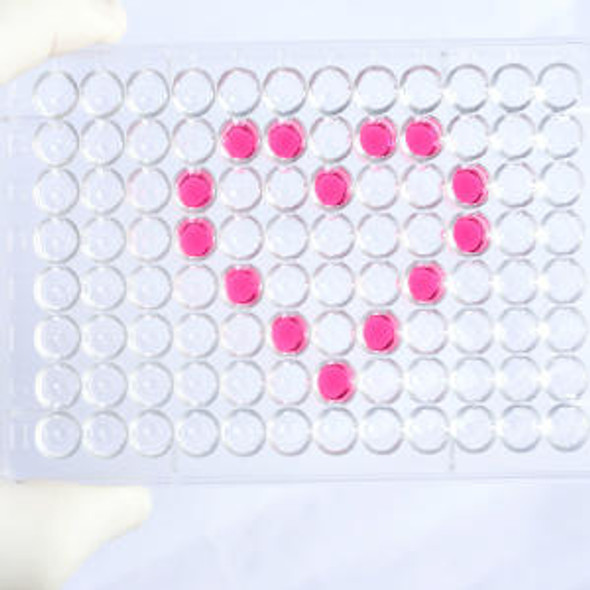Rat Sarcoplasmic / endoplasmic reticulum calcium ATPase 1 / Atp2a1 ELISA Kit (RTFI00399)
- SKU:
- RTFI00399
- Product Type:
- ELISA Kit
- Size:
- 96 Assays
- Uniprot:
- Q64578
- Sensitivity:
- 0.188ng/ml
- Range:
- 0.313-20ng/ml
- ELISA Type:
- Sandwich
- Synonyms:
- Atp2a1, SERCA1, SR Ca, 2+-ATPase 1, Sarcoplasmic, endoplasmic reticulum calcium ATPase 1, Endoplasmic reticulum class 1, 2 Ca, 2+ ATPase, Calcium pump 1, Calcium-transporting ATPase sarcoplasmic reticulum type, fast twitch skeletal muscle isoform
- Reactivity:
- Rat
- Research Area:
- Cell Biology
Description
Rat Sarcoplasmic/endoplasmic reticulum calcium ATPase 1/Atp2a1 ELISA Kit
The Rat Sarcoplasmic/Endoplasmic Reticulum Calcium ATPase 1 (ATP2A1) ELISA Kit is a powerful tool for accurately measuring levels of ATP2A1 in rat samples such as serum, plasma, and cell culture supernatants. This kit is designed with high sensitivity and specificity, ensuring reliable and reproducible results for a variety of research applications.ATP2A1 is a key enzyme involved in calcium homeostasis within muscle cells, playing a critical role in muscle contraction and relaxation.
Dysregulation of ATP2A1 has been linked to conditions such as heart failure, skeletal muscle disorders, and neurodegenerative diseases, making it a valuable biomarker for studying and potentially treating these conditions.Overall, the Rat Sarcoplasmic/Endoplasmic Reticulum Calcium ATPase 1 (ATP2A1) ELISA Kit is a valuable tool for researchers looking to study the role of ATP2A1 in muscle function and related diseases in rat models.
| Product Name: | Rat Atp2a1 (Sarcoplasmic/endoplasmic reticulum calcium ATPase 1) ELISA Kit |
| Product Code: | RTFI00399 |
| Size: | 96 Assays |
| Target: | Rat Atp2a1 |
| Alias: | Atp2a1, SERCA1, SR Ca, 2+-ATPase 1, Sarcoplasmic, endoplasmic reticulum calcium ATPase 1, Endoplasmic reticulum class 1, 2 Ca, 2+ ATPase, Calcium pump 1, Calcium-transporting ATPase sarcoplasmic reticulum type, fast twitch skeletal muscle isoform |
| Reactivity: | Rat |
| Detection Method: | Sandwich ELISA, Double Antibody |
| Sensitivity: | 0.188ng/ml |
| Range: | 0.313-20ng/ml |
| Storage: | 4°C for 6 months |
| Note: | For Research Use Only |
| Recovery: | Matrices listed below were spiked with certain level of Rat Atp2a1 and the recovery rates were calculated by comparing the measured value to the expected amount of Rat Atp2a1 in samples. | ||||||||||||||||
| |||||||||||||||||
| Linearity: | The linearity of the kit was assayed by testing samples spiked with appropriate concentration of Rat Atp2a1 and their serial dilutions. The results were demonstrated by the percentage of calculated concentration to the expected. | ||||||||||||||||
| |||||||||||||||||
| Intra-Assay: | CV <8% | ||||||||||||||||
| Inter-Assay: | CV <10% |
| Uniprot: | Q64578 |
| UniProt Protein Function: | ATP2A1: This magnesium-dependent enzyme catalyzes the hydrolysis of ATP coupled with the translocation of calcium from the cytosol to the sarcoplasmic reticulum lumen. Contributes to calcium sequestration involved in muscular excitation/contraction. Associated with sarcolipin (SLN) and phospholamban (PLN). Increased contractile activity leads to a decrease in SERCA1 expression, while decreased contractile activity leads to an increase in SERCA1 expression. Skeletal muscle, fast twitch muscle (type II) fibers. Reversibly inhibited by phospholamban (PLN) at low calcium concentrations. Dephosphorylated PLN decreases the apparent affinity of the ATPase for calcium. This inhibition is regulated by the phosphorylation of PLN. Belongs to the cation transport ATPase (P-type) (TC 3.A.3) family. Type IIA subfamily. 2 isoforms of the human protein are produced by alternative splicing. |
| UniProt Protein Details: | Protein type:EC 3.6.3.8; Transporter, ion channel; Endoplasmic reticulum; Hydrolase; Membrane protein, multi-pass; Transporter; Membrane protein, integral Chromosomal Location of Human Ortholog: 16p12.1 Cellular Component: I band; endoplasmic reticulum membrane; sarcoplasmic reticulum membrane; membrane; sarcoplasmic reticulum; perinuclear region of cytoplasm; integral to membrane; ER-Golgi intermediate compartment Molecular Function:protein binding; protein homodimerization activity; calcium-transporting ATPase activity; calcium ion binding; ATP binding Biological Process: apoptotic mitochondrial changes; positive regulation of fast-twitch skeletal muscle contraction; maintenance of mitochondrion localization; metabolic process; reduction of endoplasmic reticulum calcium ion concentration; elevation of endoplasmic reticulum calcium ion concentration; calcium ion transport; regulation of striated muscle contraction; blood coagulation; transmembrane transport; elevation of mitochondrial calcium ion concentration; negative regulation of striated muscle contraction Disease: Brody Myopathy |
| NCBI Summary: | This gene encodes one of the SERCA Ca(2+)-ATPases, which are intracellular pumps located in the sarcoplasmic or endoplasmic reticula of muscle cells. This enzyme catalyzes the hydrolysis of ATP coupled with the translocation of calcium from the cytosol to the sarcoplasmic reticulum lumen, and is involved in muscular excitation and contraction. Mutations in this gene cause some autosomal recessive forms of Brody disease, characterized by increasing impairment of muscular relaxation during exercise. Alternative splicing results in three transcript variants encoding different isoforms. [provided by RefSeq, Oct 2013] |
| UniProt Code: | Q64578 |
| NCBI GenInfo Identifier: | 554506571 |
| NCBI Gene ID: | 487 |
| NCBI Accession: | NP_001273004.1 |
| UniProt Secondary Accession: | Q64578,O14984, A8K5J9, B3KY17, |
| UniProt Related Accession: | O14983 |
| Molecular Weight: | 95,199 Da |
| NCBI Full Name: | sarcoplasmic/endoplasmic reticulum calcium ATPase 1 isoform c |
| NCBI Synonym Full Names: | ATPase, Ca++ transporting, cardiac muscle, fast twitch 1 |
| NCBI Official Symbol: | ATP2A1 |
| NCBI Official Synonym Symbols: | ATP2A; SERCA1 |
| NCBI Protein Information: | sarcoplasmic/endoplasmic reticulum calcium ATPase 1; calcium pump 1; SR Ca(2+)-ATPase 1; endoplasmic reticulum class 1/2 Ca(2+) ATPase; calcium-transporting ATPase sarcoplasmic reticulum type, fast twitch skeletal muscle isoform |
| UniProt Protein Name: | Sarcoplasmic/endoplasmic reticulum calcium ATPase 1 |
| UniProt Synonym Protein Names: | Calcium pump 1; Calcium-transporting ATPase sarcoplasmic reticulum type, fast twitch skeletal muscle isoform; Endoplasmic reticulum class 1/2 Ca(2+) ATPase |
| Protein Family: | Sarcoplasmic/endoplasmic reticulum calcium ATPase |
| UniProt Gene Name: | ATP2A1 |
| UniProt Entry Name: | AT2A1_HUMAN |
| Step | Procedure |
| 1. | Set standard, test sample and control (zero) wells on the pre-coated plate respectively, and then, record their positions. It is recommended to measure each standard and sample in duplicate. Wash plate 2 times before adding standard, sample and control (zero) wells! |
| 2. | Aliquot 0.1ml standard solutions into the standard wells. |
| 3. | Add 0.1 ml of Sample / Standard dilution buffer into the control (zero) well. |
| 4. | Add 0.1 ml of properly diluted sample ( Human serum, plasma, tissue homogenates and other biological fluids.) into test sample wells. |
| 5. | Seal the plate with a cover and incubate at 37°C for 90 min. |
| 6. | Remove the cover and discard the plate content, clap the plate on the absorbent filter papers or other absorbent material. Do NOT let the wells completely dry at any time. Wash plate X2. |
| 7. | Add 0.1 ml of Biotin- detection antibody working solution into the above wells (standard, test sample & zero wells). Add the solution at the bottom of each well without touching the side wall. |
| 8. | Seal the plate with a cover and incubate at 37°C for 60 min. |
| 9. | Remove the cover, and wash plate 3 times with Wash buffer. Let wash buffer rest in wells for 1 min between each wash. |
| 10. | Add 0.1 ml of SABC working solution into each well, cover the plate and incubate at 37°C for 30 min. |
| 11. | Remove the cover and wash plate 5 times with Wash buffer, and each time let the wash buffer stay in the wells for 1-2 min. |
| 12. | Add 90 µL of TMB substrate into each well, cover the plate and incubate at 37°C in dark within 10-20 min. (Note: This incubation time is for reference use only, the optimal time should be determined by end user.) And the shades of blue can be seen in the first 3-4 wells (with most concentrated standard solutions), the other wells show no obvious color. |
| 13. | Add 50 µL of Stop solution into each well and mix thoroughly. The color changes into yellow immediately. |
| 14. | Read the O.D. absorbance at 450 nm in a microplate reader immediately after adding the stop solution. |
When carrying out an ELISA assay it is important to prepare your samples in order to achieve the best possible results. Below we have a list of procedures for the preparation of samples for different sample types.
| Sample Type | Protocol |
| Serum: | If using serum separator tubes, allow samples to clot for 30 minutes at room temperature. Centrifuge for 10 minutes at 1,000x g. Collect the serum fraction and assay promptly or aliquot and store the samples at -80°C. Avoid multiple freeze-thaw cycles. If serum separator tubes are not being used, allow samples to clotovernight at 2-8°C. Centrifuge for 10 minutes at 1,000x g. Removeserum and assay promptly or aliquot and store the samples at-80°C. Avoid multiple freeze-thaw cycles. |
| Plasma: | Collect plasma using EDTA or heparin as an anti-coagulant. Centrifuge samples at 4°C for 15 mins at 1000 × g within 30 mins of collection. Collect the plasma fraction and assay promptly or aliquot and store the samples at -80°C. Avoid multiple freeze-thaw cycles.Note: Over haemolysed samples are not suitable for use with this kit. |
| Urine & Cerebrospinal Fluid: | Collect the urine (mid-stream) in a sterile container, centrifuge for 20 mins at 2000-3000 rpm. Remove supernatant and assay immediately. If any precipitation is detected, repeat the centrifugation step. A similar protocol can be used for cerebrospinal fluid. |
| Cell Culture Supernatant: | Collect the cell culture media by pipette, followed by centrifugation at 4°C for 20 mins at 1500 rpm. Collect the clear supernatant and assay immediately. |
| Cell Lysates: | Solubilize cells in lysis buffer and allow to sit on ice for 30 minutes. Centrifuge tubes at 14,000 x g for 5 minutes to remove insoluble material. Aliquot the supernatant into a new tube and discard the remaining whole cell extract. Quantify total protein concentration using a total protein assay. Assay immediately or aliquot and store at ≤ -20°C. |
| Tissue Homogenates: | The preparation of tissue homogenates will vary depending upon tissue type. Rinse tissue with 1X PBS to remove excess blood & homogenizein 20ml of 1X PBS (including protease inhibitors) and store overnight at ≤ -20°C. Two freeze-thaw cycles are required to break the cell membranes. To further disrupt the cell membranes you can sonicate the samples. Centrifuge homogenates for 5 mins at 5000xg. Remove the supernatant and assay immediately or aliquot and store at -20°C or-80°C. |
| Tissue Lysates: | Rinse tissue with PBS, cut into 1-2 mm pieces, and homogenize with a tissue homogenizer in PBS. Add an equal volume of RIPA buffer containing protease inhibitors and lyse tissues at room temperature for 30 minutes with gentle agitation. Centrifuge to remove debris. Quantify total protein concentration using a total protein assay. Assay immediately or aliquot and store at ≤ -20 °C. |
| Breast Milk: | Collect milk samples and centrifuge at 10,000 x g for 60 min at 4°C. Aliquot the supernatant and assay. For long term use, store samples at -80°C. Minimize freeze/thaw cycles. |






